It was on a sunny morning in September that I set off to begin my first ever Out to Play residency. I have long been fascinated by traditional stories, and the histories they represent, and have been striving as a participatory artist to create work that is socially engaged and explores topics and issues that are exciting and meaningful to my participants. In previous projects I have often been struck by the real concern, care and compassion children and young people have for our planet, so this is something I was keen to explore and celebrate with this project. I love the idea of looking backwards (i.e. into the past) to find the way forwards, which was where the idea for this residency sprung from; children would be invited to take up a hundreds of years old quest and, through doing so, learn the secrets of Mother Nature, and how to care for and respect our natural world.
Dear Explorers
My name is Saffron; I’m writing you this letter because I need your help! You see, I’m an adventurer about to set off on a very exciting, and very important quest… but I can’t find my equipment! It’s incredibly special, it belonged to my great, great grandmother who hid it years ago.
I’ve found a map – and I think the equipment might be hidden in your playground! I need some experts to help me, would you please come outside to look for it?
See you soon!
Saffron
The letter above preceded my arrival at Broomhill and St Rose of Lima Primary schools, where I had the privilege of adventuring alongside children in Primary 2, 3 and 4 at Broomhill, and with Primary 3 and 4, and an Upper School Nurture Group at St Rose of Lima. Luckily, all of the children were keen to help me out!
What was our quest? We were charged with discovering the Secret Power of Mother Nature; how does she care for our planet? And can we help her to look after it? In the playground I explained to the classes that the quest had been started by my great, great grandmother many years ago but was never finished… Having found a map which led me to their playground, I had decided to take up the challenge myself, but I couldn’t do it alone!
I introduced the children to the playground maps I had found that would aid us on our quest, and a mysterious riddle which led us to the discovery of my great, great grandmother’s equipment, hidden by tree stumps – a forgotten forest.


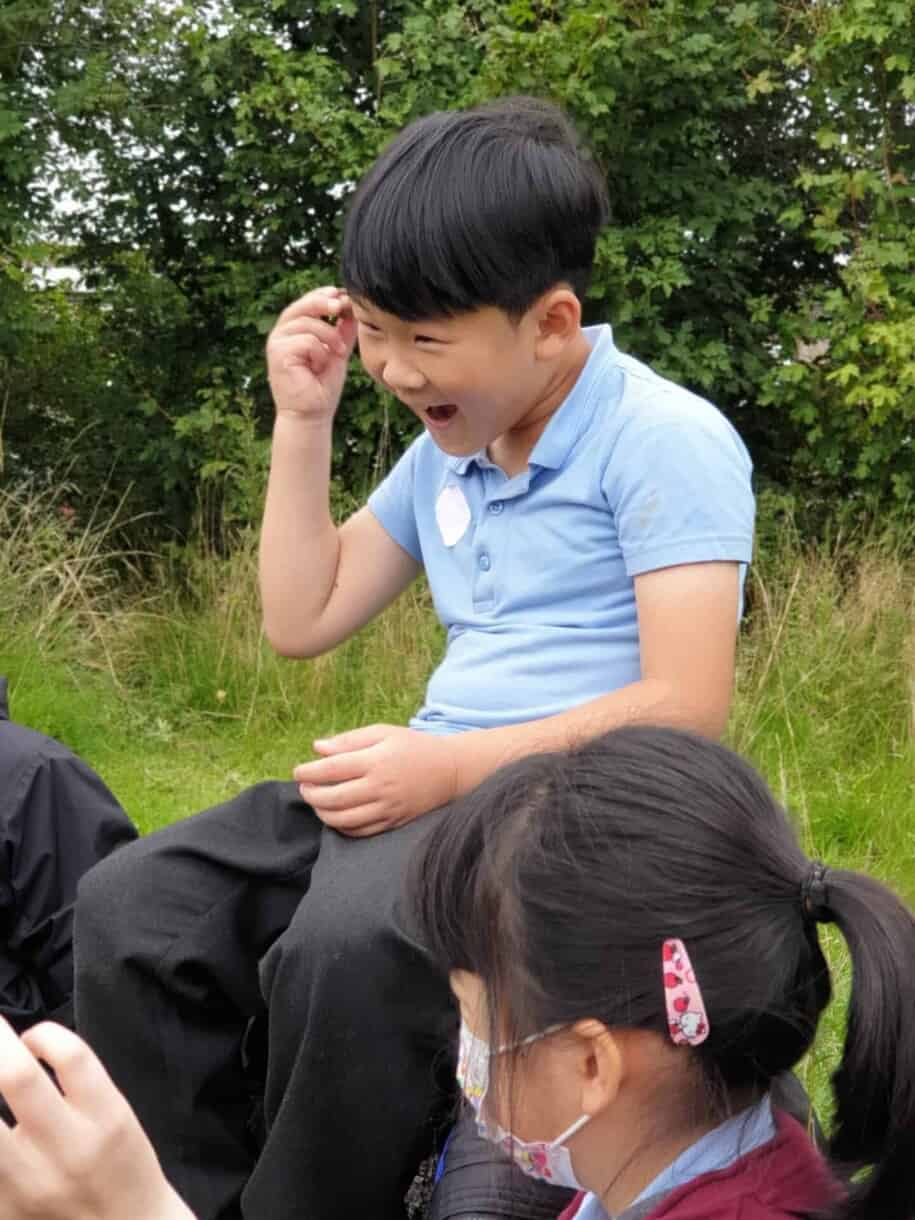
Over the weeks, we would explore different areas of the playground;
Broomhill explored The Vast Tundra of Wonder; Snake’s Hill; The Orchard; and The Algae Pond, with regular visits to the Story Trees, three beautiful mature trees in their playground.
St Rose of Lima explored The Valley of Discovery; The Hide Out; The Trees of Wisdom; Hedgehog Hill; and the Pagoda of Peace, with visits to their Storytelling Spot, a beautiful circle of tree stump seats perched on top of a hill, with views out across to the South.


Although situated at opposite sides of Glasgow, there were some interesting similarities in the layouts and features of the playgrounds at Broomhill and St Rose of Lima. Both featured excellent grassy areas, and hills with fantastic hilltop views, both also had a range of young and mature trees including birch, alder, sycamore, rowan, hawthorn and apple trees.
Both playgrounds also had areas which could be described as rarely utilised. The hilltop area at Broomhill, which we came to call The Orchard was one such area, when I invited P.4 classes to explore up there in week one of the residency one child told me they had never been up there before! At the end of the session when I asked children to consider something they had seen, felt or imagined during the adventure another child suggested the view from the hilltop, where we could see all the way to Whitelee Wind Farm; we all spent a collective moment admiring the view together.
Meanwhile, St Rose of Lima’s playground was full of fascinating wooded areas, and was really expansive meaning that some parts of the playground weren’t frequently visited – particularly the Trees of Wisdom in the far North West corner, which became a shady refuge for us for many of the sessions, as we experienced unusually hot and sunny days for the vast majority of the residency. In week two, where we explored trees, these trees offered us a surprise! One of them was covered in a long, silvery snail’s trail, which perfectly demonstrated the interaction between creatures and trees.
An unintended but welcome discovery was that the idea of going on a quest really appealed to and sparked the imaginations of the children – as many had experience in playing video games which featured quests. As such, they were full of ideas for the kinds of things we might encounter along the way! I found this was particularly useful in engaging the boys in our adventures, as this was very much in their wheelhouse. The quest framework also gave us a clear structure for each session; solve the riddle, find the treasure chest, examine its contents, then take part in activities and hear stories which would help us gain an understanding of, and appreciation for one of Mother Nature’s Powers – Trees/Plant Life, Water, Biodiversity and Us. Ultimately we considered that it was the way that these different facets of our natural world collaborate and support each other that truly supplied Mother Nature her powers.
Taking inspiration from Sophie, a fellow Eco Drama Artist, I drew upon stories from different countries and cultures throughout the residency – I noticed pupils really enjoyed guessing where each story would come from, and as Sophie has noted previously, when those stories related to the experiences and cultures of children in the class, this was really special.
Nature Under our Noses
The aim of our first adventure was to spark the children’s imaginations and create a sense of wonder for the nature around us. I shared Scottish stories with the classes. This week the Primary 2-4 children were not just visited by myself, but also by a rather mysterious and shy Scottish forest sprite; The Ghillie Dhu! We unexpectedly came across a fairy washing line, hung with clothes patched with leaves. Surely this was a sign of their adventuring prowess, as the Ghillie Dhu reveals their presence only to the most skilled adventurers. While St Rose of Lima’s Upper School Nurture Group encountered a dragon in the story Saving the Forest, a tale of Bride and Beira – goddesses of the Seasons. One highlight of this week was when I invited Nurture Group pupils to fly like the dragon down the large hill in the playground, the invitation was met with some trepidation, but before long one of the pupils was running at full speed down the hill with their arms outstretched! The Ghillie Dhu story clearly stuck in the minds of P.2-4 pupils, the discovery of the washing line served to bring the story vividly to life. Many pupils went on to create art work inspired by them. Some classes let me know that they received letters from the Ghillie Dhu over the following weeks, and I was delighted to hear that one participating child even designed a maths game that featured the Ghillie Dhu as a character.
Seeds Into Trees
This session was designed not only to highlight the importance of trees in our eco-system, but also to inspire children to take steps to appreciate and protect trees. Primary Two heard the Zimbabwean folk tale of the Awongalema tree, focusing on the themes of nature gratitude, and exploring different biomes through a journey from the rainforests of Zimbabwe, across the Savannah all the way to the snowy cold Tundra atop Mt Kilimanjaro, in Tanzania.
Primary 3, 4 and the Nurture Group heard the Indian folk tale Amarita’s Tree, which was inspired by the bravery of Bishnoi people who sacrificed their lives to protect a grove of sacred Khejri trees in 1730. Their actions went on to inspire the Chipko movement of the 1970’s and 80’s, perhaps better known internationally as the Tree Hugging Movement. We considered the functions of trees, and ways that we can peacefully care for them, while using drama to present scenes introducing trees from around the world – Baobab, Eucalyptus, Mango, Sakura/Cherry, and Apple Trees.
Some highlights from this week included P.3 children at Broomhill imagining sticks as magic wands, and pine cones as Christmas Trees for fairies, and P.3/4 children at St Rose of Lima clapping and dancing along as I played an Indian dance on Kalimba as part of their story.

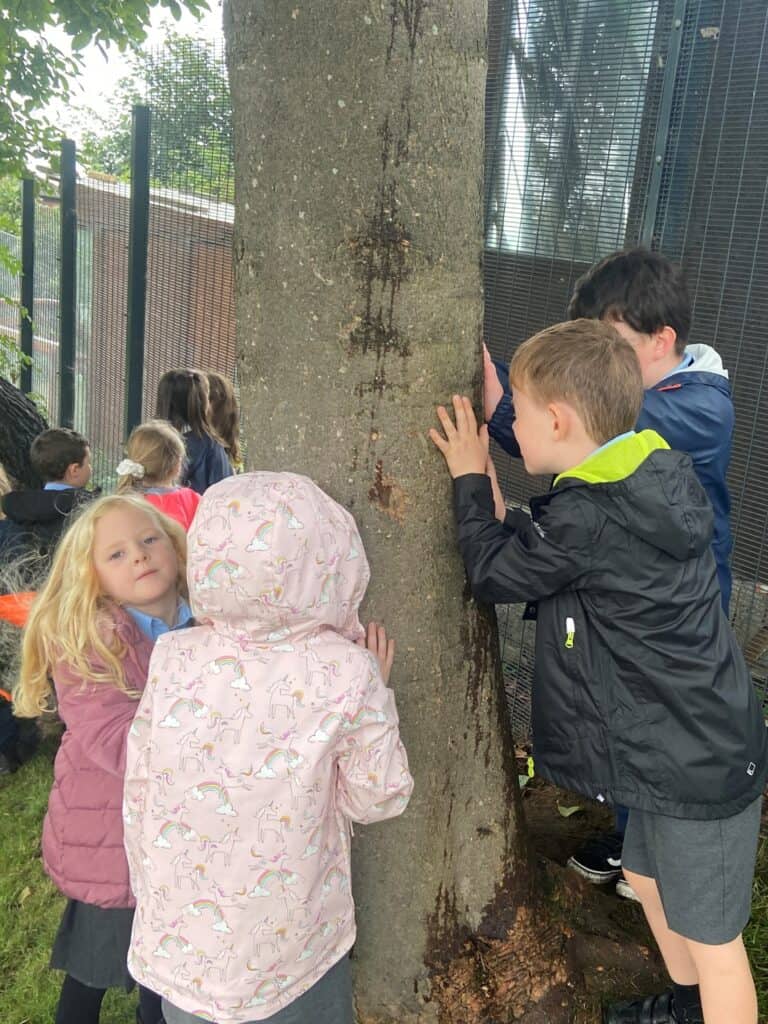
A World of Water
Children encountered the Aboriginal Dreamtime Myth Tiddilik the Frog, in this session where we considered the role of water in our eco-system. A note I had taken from initial meetings with teachers was the children’s interest in science and technology. After interacting with some beautiful sea shells and creating our very own ocean in the playground with the help of Eco Drama’s fantastically gigantic parachute we used physical theatre to create brand new inventions which would help to clear litter from our oceans, inspired by real life inventions including The Interceptor, and The WasteShark.
When I asked P.4 children at Broomhill what kinds of things they imagined might live in the Algae Pond featured on their map, one suggested the Loch Ness Monster, which led to an impromptu whole class physicalising of Nessie in the playground! I was particularly struck by the children’s excitement at the prospect of creating something which might help to clean up our oceans, and in turn look after marine life.
Inspiring hope for our planet and for nature is one of Eco Drama’s goals for this project, and through drama we were able to imagine ways we might contribute to that, it was a very rewarding session and, for myself, a real reminder of the power of drama to inspire through embodied learning experiences.


Teeming With Life
Lots of us have a good understanding of the function of bees as pollinators in our eco-system, but did you know that wasps are pollinators too? In our fourth session we considered the web of life, with Primary 3, 4 and Nurture Group pupils making their own interconnectedness webs in the playground, and P.2 searching for a hidden bumble bee in their playground.
Through the Balinese story The Grumpy Gecko we learned that lots of different creatures and animals rely on each other for food and shelter, and many pupils were delighted to learn about dung beetles in particular! We followed this by creating our own versions of Just So Stories, inspired by Rudyard Kipling. Pupils worked together in groups to present 10 second mini stories which included the likes of How the Penguin Got its Waddle, How the Parrot got its Rainbow Feathers, How the Wolf got its Howl and How the Bee got its Wings.
Take it Away, Teachers!
In the final week of the residency it was over to the class teachers to plan and lead their own Out to Play adventure, following on from a twilight CPD session I delivered the previous week. I was delighted by their enthusiasm and creativity. At St Rose of Lima, teachers worked collaboratively to plan Out to Play sessions exploring Autumn with the Choctaw story How Grandmother Spider Brought Fire and a beautiful poem exploring the seasons, Animal Welfare and Conservation with the Kazakh story The Magic Garden, and World Geography and Trees with the Zimbabwean folk tale Awongalema. I was particularly impressed by the staff’s nature connection activities which ranged from collecting pieces of autumn, to treasure hunts amongst the trees, to painting on our hands with mud!
At Broomhill, teachers led sessions exploring Autumn and the nature of darkness and light again using the Choctaw story How Grandmother Spider Brought Fire, Under The Sea with the Caribbean story Anansi and the Turtle, Trees and Food Waste through the Welsh story Stink Water and Travel and Food Miles through a lovely story about a Railway Station in the middle of the desert, and the wonderful places that could be explored from there. Staff at Broomhill made great use of the different areas of their playground, and brought along some fantastic props and materials which really brought their sessions to life.
I was so pleased to hear that both schools are already planning ways to continue their Out to Play journey, but with such proactive and talented staff at both schools, I am not surprised!
At the end of the wonderful teacher-led sessions I gifted each class a daffodil bulb to be planted in their playground, a final piece of magic that would pop up in Spring and remind them of their adventures…
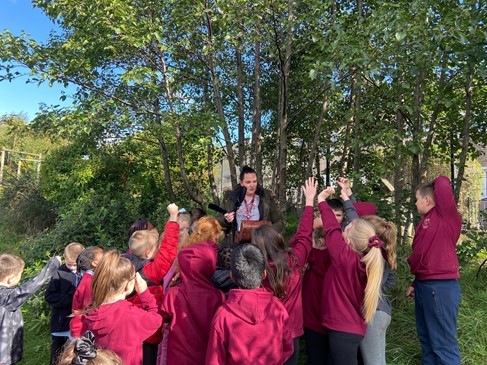




We finished the residency with a final CPD session, which included Teacher Awards to celebrate the work of the participating staff members – with categories such as Brilliant use of Teacher in Role, Dazzling Drama Games and Incredibly Inventive Lure and Lesson Theme, it was wonderful to recognise the work of the teachers involved.
As part of the final CPD session, St Rose of Lima’s participating teachers had the opportunity to share and demonstrate activities from their sessions for staff members who were encountering the project for the first time, I have no doubt that their experience will allow other staff members to begin on their own outdoor, arts-based adventures with their classes. There was plenty of hilarity as we explored different drama techniques and activities!
As all classes at Broomhill Primary will be taking part in Out to Play during this school year, I delivered a final CPD session for participating staff, which delved deeper into techniques for process drama, it was lovely to be able to leave staff with a bank of ideas to be used in future sessions which could build upon the work we did within the residency.
My first Out to Play experience has been so exciting, if exhausting at times! I am really looking forward to carrying on my Out to Play journey and continuing to develop my outdoor, socially and ecologically engaged practice. In reflecting upon the residency, I have been considering the magic of being outside, and hope to take this idea of magic forwards into future adventures.
I shall finish this blog with a big THANK YOU to all participating pupils and staff members, for bringing all of their curiosity, empathy and creativity to our quest – I enjoyed every minute of adventuring with them.

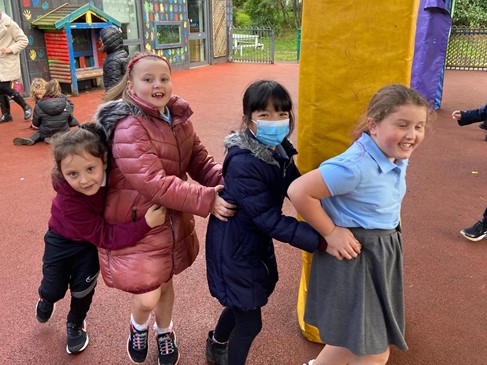

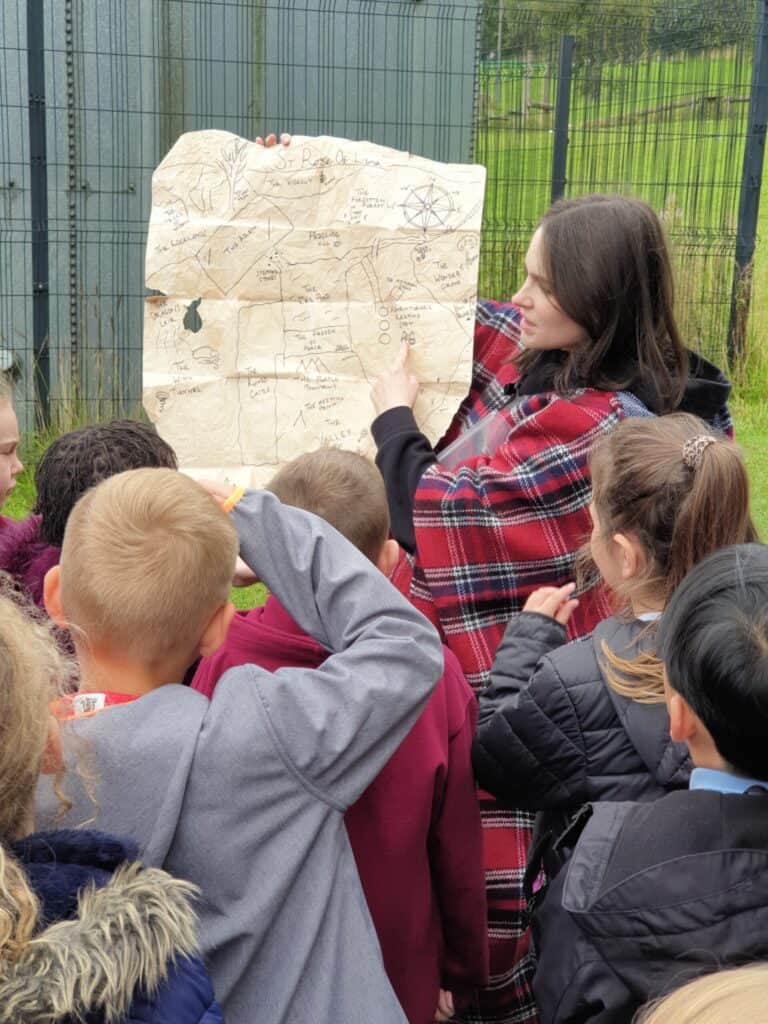



![glasgow city council logo [black] Glasgow City Council logo](https://ecodrama.co.uk/wp-content/uploads/2023/12/glasgow-city-council-logo-black.png)

